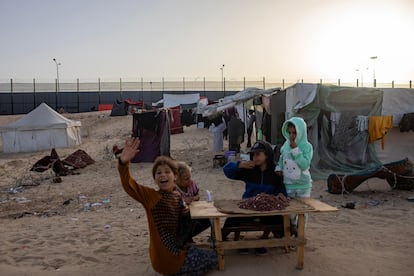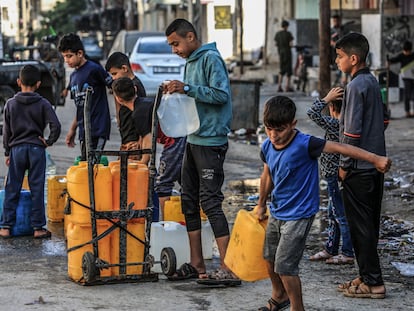Gaza once again the main theater of war after risk of regional escalation cools
The big question now is whether Israel will invade Rafah, despite international calls for restraint. ‘This is a war against civilians, not against Hamas,’ says one Gazan who escaped the southern city fearing an Israeli ground invasion

With the recent escalation between Israel and Iran reportedly over, at least for now, the focus in the Middle East has returned to Gaza. In the Palestinian enclave, there is no sign of a cease-fire deal being struck any time soon. But the big question hanging over Gaza is whether Israeli Prime Minister Benjamin Netanyahu will decide to invade the southern city of Rafah, as he promised to do weeks ago. Will he go through with this ground operation, even though Israel’s main ally, the United States, has warned against it? Will he listen to the U.N. and the humanitarian organizations that argue it is impossible to displace the 1.5 million refugees in the city?
“I don’t want to wait until the last second, before the Israeli invasion of Rafah, to leave,” says Samir Zaqout, 58, deputy director of the Al Mezan Center for Human Rights, via voice messages, who, just in case, has already escaped to the middle part of Gaza. “We all think that this is a war against civilians and against civilian infrastructure, not against Hamas. People think they are going to be killed or that their house is going to be destroyed, especially since Netanyahu singled out Rafah.” Israel maintains that Rafah is Hamas’s last remaining stronghold.
The Israeli prime minister took the middle road when, with the bulk of the international community calling for restraint, he ordered on Friday a measured and controlled attack against Iran, without officially causing casualties or damaging its nuclear program. Netanyahu did so in retaliation for Tehran’s attack last Sunday morning, which also left no fatalities, although it wounded a Bedouin girl. Israel was the last to strike before this return to calm and, in some way, it has left the mark of its superiority.
But on the battlefield in Gaza, Netanyahu has not achieved his objectives: ending Hamas and bringing back the more than 130 Israeli hostages still there, many of whom have dead. Like every Saturday, protesters took to the streets of Tel Aviv to demonstrate against the government and call for the release of hostages
That is why the logic of what happened with Iran, when international pressure was able to stop a major attack, cannot be applied to the war in Gaza. The deadly Hamas attack on October 7, which killed 1,200 people in Israel, sparked the war in Gaza and — more than half a year later — continues to frame the decisions made by the increasingly unpopular Netanyahu.
In the Gaza Strip — where Israeli forces have killed more than 34,000 people, according to data from the Hamas-run Gaza Ministry of Health, Gazans are aware that Israel’s brutal offensive remains underway. Without knowing when or how the military operation announced by Netanyahu will be carried out, citizens have been fleeing Rafah, near the Egyptian border, for weeks. They have been moving to other areas of Gaza that they believe to be safer, but have come up against the reality of the conflict: jumping from one hell to another. There is no shelter and no one is safe, as the NGOs on the ground continually warn.
Constant drone of drones
This has been confirmed by Samir Zaqout, the deputy director of the Al Mezan Center, who, after living with relatives in Rafah for several months, has fled again, along with his wife. In a kind of diabolical game of ping-pong, they have headed further north. They are now settled in Az Zawayda, between Deir al-Balah and the Nuseirat refugee camp. There, he says, life continues to be “horrible” and there is “permanent risk” from attacks by the occupation troops. That is why he has decided — and managed—to send his son Nada, 15, and his daughters, Salma, 22, and Farah, 32, to Egypt. Israeli drones hum in the background as Zaqout’s records his voice note: “Do you hear them?” he asks.
The danger of bombings and the humanitarian crisis have made survival difficult in any area of Gaza. “I spend most of my time trying to get water,” says Zaqout. Municipal authorities only manage to provide Gazans with water for a short period of time, with no pressure, every 12 to 14 days. Then there are other problems — which are serious, but have become a daily occurrence — such as the lack of electricity, which, Zaqout explains, also means that fresh food, such as chicken or milk, cannot be preserved because the refrigerators do not work. “Eating packaged food for so many months is killing people,” he concludes, adding that food is scarce and its price has skyrocketed.
In the wake of Israeli attacks on medical infrastructure, lack of healthcare and obtaining medicines are other problems that have become part of the obstacle course for survival, as well as the increasing difficulty in obtaining cash. “Although I have money, I haven’t had access to my bank for three months,” complains the deputy director of Al Mezan. His situation, he stresses, is not as difficult as that of thousands of impoverished families in Gaza, who were suffering before the current war and depend on remittances from relatives abroad.
“The only way to halt famine is through regular and sustained access and a humanitarian ceasefire,” the World Food Program (WFP) warned on Thursday in a post on the social network X (formerly Twitter). This organization, dependent on the U.N., says that Israel is still not allowing enough trucks with humanitarian aid into Gaza. So far this month, 392 trucks have entered with food, which is almost the same number as in March, but half the figure in January, adds the same source.
Ceasefire talks stalled
Negotiations for a ceasefire in Gaza also seem to be stalled. The political leader of Hamas, Ismail Haniyeh, was received on Saturday by the president of Turkey, Recep Tayyip Erdoğan. The Turkish president, an Islamist like the Palestinian fundamentalist group, is not part of the main group of countries (the United States, Qatar and Egypt) mediating a deal, but he is trying to pull strings to end the conflict.
Meanwhile, the so-called Freedom Flotilla, which brings together organizations from several countries, intends to set sail from Turkey to Gaza with more than 5,000 tons of humanitarian aid. Its goal is to break the Israeli blockade. Erdoğan expressed confidence that “one day Israel will pay the price for the oppression it inflicts on the Palestinians” and told Haniyeh that “all efforts are being made to create the independent state of Palestine which is the key to regional peace and to bringing permanent peace to the region,” reports Andrés Mourenza.
Erdoğan also asked the Hamas leader for Palestinians to unite, in reference to the failed attempts to achieve a joint government with the other political factions in Gaza and West Bank. Turkey has increased its diplomatic contacts in a bid to prevent a further escalation of tension in the Middle East, acting as an intermediary between Iran and the United States, and in meetings with neighboring countries and Hamas.
Israel’s Foreign Minister Israel Katz was quick to criticize the meeting between Erdoğan and Haniyeh: “Muslim Brotherhood alliance: rape, murder, desecration of corpses and the burning of babies. Erdoğan, shame on you!” he posted on X (formerly Twitter). Seven of Haniyeh’s relatives (three children and four grandchildren) were killed in an Israeli bombing in Gaza on April 10.
Hamas is considering moving its political headquarters out of Qatar, according to the American newspaper The Wall Street Journal, which, according to Israeli media, could alter ceasefire talks.
Sign up for our weekly newsletter to get more English-language news coverage from EL PAÍS USA Edition
Tu suscripción se está usando en otro dispositivo
¿Quieres añadir otro usuario a tu suscripción?
Si continúas leyendo en este dispositivo, no se podrá leer en el otro.
FlechaTu suscripción se está usando en otro dispositivo y solo puedes acceder a EL PAÍS desde un dispositivo a la vez.
Si quieres compartir tu cuenta, cambia tu suscripción a la modalidad Premium, así podrás añadir otro usuario. Cada uno accederá con su propia cuenta de email, lo que os permitirá personalizar vuestra experiencia en EL PAÍS.
¿Tienes una suscripción de empresa? Accede aquí para contratar más cuentas.
En el caso de no saber quién está usando tu cuenta, te recomendamos cambiar tu contraseña aquí.
Si decides continuar compartiendo tu cuenta, este mensaje se mostrará en tu dispositivo y en el de la otra persona que está usando tu cuenta de forma indefinida, afectando a tu experiencia de lectura. Puedes consultar aquí los términos y condiciones de la suscripción digital.
More information
Archived In
Últimas noticias
$3,000 and a plane ticket: The United States increases incentives for migrants to self-deport before the end of the year
Charles Dubouloz, mountaineering star, retires at 36 with a farewell tour inspired by Walter Bonatti
From the White House to diplomatic gifts: Lego wins over adult fans, brick by brick
Kate Winslet makes her directorial debut: ‘There aren’t more female directors because we’re busy raising children’
Most viewed
- Families demand repatriation of bodies of Colombians who died in Ukraine: ‘This war is a slaughterhouse for foreigners’
- The low-cost creative revolution: How technology is making art accessible to everyone
- Liset Menéndez de la Prida, neuroscientist: ‘It’s not normal to constantly seek pleasure; it’s important to be bored, to be calm’
- Christian Louboutin: ‘Young people don’t want to be like their parents. And if their parents wear sneakers, they’re going to look for something else’
- Christmas loses its festive spirit: ICE fears cast shadow over religious celebrations










































